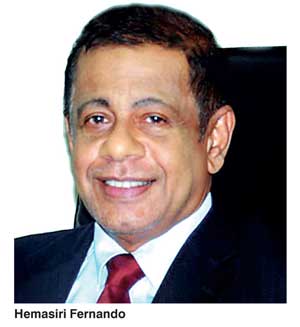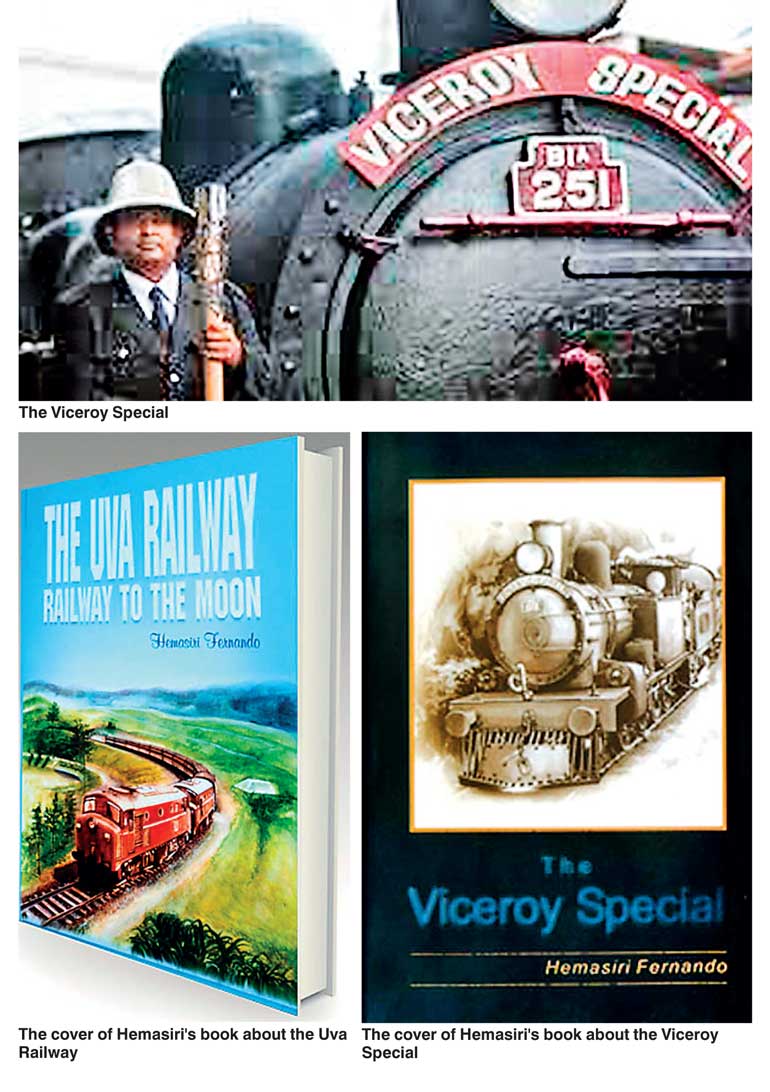Monday Mar 31, 2025
Monday Mar 31, 2025
Monday, 4 July 2016 00:10 - - {{hitsCtrl.values.hits}}
A railway enthusiast to a fault
Hemasiri Fernando is known in Sri Lanka and abroad as a sports administrator, bureaucrat, banker and entrepreneur. He is little known as a train enthusiast, though it was his hobby from his early childhood. That was because it was kept a secret from the world  at large. Only a few who were very close to him were privy to it. But that secrecy surrounding his hobby is no more. It has now been unveiled by Hemasiri himself.
at large. Only a few who were very close to him were privy to it. But that secrecy surrounding his hobby is no more. It has now been unveiled by Hemasiri himself.
Through two publications, done with extensive research but addressed to laymen like him, he has revealed his obsessive enthusiasm for trains. The first publication – The Viceroy Special – came out of press in 2013 and has run three rounds of printing now. The Second – The Uva Railway: The Railway to the Moon – was out in 2014. They are full of history, rare photographs and tech facts about trains. Thus, they should be collectors’ items for those interested in learning of the country’s railway history.
The Viceroy Special Project
The Viceroy Special was a special edition done by Hemasiri Fernando to commemorate the Silver Jubilee of the refurbished ‘Viceroy Special’ that began to roll along the country’s rails from 1986 demonstrating its heyday magnificence to train enthusiasts. He himself was a part of the Viceroy Special, having worked for 18 months at the Dematagoda Running Shed and Ratmalana Workshop of the Railway Department.
Says Fernando in the preface to the book: “The Viceroy Special is a product that was meant for the upmarket tourists and the first 15 years had been volatile due to the adverse situation in the country. Nevertheless, there were some tours operated, mainly in the Western and the Southern part of the island that were sufficient to keep the project afloat. The Ceasefire Agreement between the Government and the LTTE in 2001 gave new momentum to the Viceroy Operation with a fair amount of tourist arrivals. During this period of 2-3 years, it had reached the optimum level of operation with sufficient revenue. This situation was back in the doldrums after the annulment of the ceasefire agreement.”
Tourist Board’s withdrawal from the project
The Ceylon Tourist Board was an original stakeholder of the Viceroy Project since it was the main beneficiary. Naturally, it should be so but its subsequent withdrawal from the project showed that it was not on the same wavelength as others in this enterprise.
Perhaps, it would have failed to understand, at that time, an important element in attracting tourists to the country: provision of a variety of entertainment. Except ancient ruins and sandy beaches, there are no other ways of keeping incoming tourists fruitfully  occupied.
occupied.
River cruise journeys in Thailand
Such a variety is provided to tourists in Thailand which entertains about 30 million tourists annually adding as high as 20% to the country’s total income. One important attraction offered to tourists in Thailand is the river cruises in Chao Phraya River.
On those cruises, tourists can wine, dine and entertain themselves to their heart’s content. The cruises start from the River City Complex on the bank of the river in Bangkok. It is like an airport terminal through which thousands of tourists pass a day but no one misses his cruise boat. That is because every passenger is looked after personally, allowing them to be even photographed with traditionally dressed staff members. Despite the fact that thousands of feet tread on its floors a day, it is clean and well-maintained, obviously a cause of envy by any airport terminal of a developed country.
Sri Lanka’s asset: Wheels on rails
Sri Lanka does not have rivers to offer such feasts to tourists. Its rivers are narrow, shallow and hostile even to small boats. But it has in readiness another unique entertainer to offer to tourists. That is, allowing them sightseeing, while wining, dining and dancing on wheels on rails. The Viceroy Special was such a golden opportunity which the country experimented with but failed midway due to bad planning. Hemasiri Fernando has explained the opportunity created as follows: “For nearly twenty years, the legacy of steam train travel faded away and the steam engines which reminded us of man’s ability to create power were isolated as heaps of junk in rail yards. The locomotives from the junk heaps were rescued with the cooperation of Sri Lanka Railways and skilled railwaymen brought out of retirement. As well as reviving engines, two old carriages were converted into luxury air-conditioned coaches. The use of traditional furnishings and period decor ensured an atmosphere of elegance and grandeur of a bygone era. The speciality of this 64 passenger train is that it offers passengers the combination of heritage, luxury and dining.”
Need for business acumen in the public sector
Like any other project in Sri Lanka, the Viceroy Special Project as a tourist attraction soon failed. Explains Hemasiri Fernando: “Since the inauguration in 1986, the Viceroy Special has had several ups and downs. The Ceylon Tourist Board withdrew from stakeholder status within months of its inauguration, but continued to offer limited assistance as and when requested. Cooperation of the CGR being the owner of the train, varied from time to time depending on the individuals occupying the post of the General Manager Railways.”
This disappointment on the part of Fernando is as expected because government bodies are not good at doing business. They may start a business with much fanfare, but pretty soon will lose steam in the absence of a threat to survival. Hence, projects are usually ill-designed with no foresight or a proper business plan. This is evident in the case of more recent white elephants like the Mattala Airport and Hambantota Harbour. If these projects are handed to the private sector under a proper public-private partnership or as an outright sale, the private initiatives characterised by the need for mitigating risks for survival would force them to strategise properly for continuity.
The failure of the Viceroy Special was simply due to a lack of such business foresight. Since the train as well as the track on which it should ply is owned by the Government Railways, the private initiatives could be brought to play a role by getting into a proper public-private partnership.
The chance meeting of two railway enthusiasts
The Viceroy Special project was born, according to Hemasiri Fernando, due to a chance meeting which he had with a stranger in the immediate aftermath of the 1983 ethnic clashes.
He was a casualty of the ethnic clashes as the owner of a small family-owned travel firm in mid-1980s when a stranger called Cliff Jones walked into his office. Jones, a Manchester-born journalist, had travelled around the country as a guest of the Ceylon Tourist Board to project a positive image of Sri Lanka to external tour operators. As a railway enthusiast, he had visited the Dematagoda Running Shed of the Railway Department and had been amazed by the rich wealth dumped all over there without being noticed by anyone in the Department or outside. It was as if the two railway enthusiasts had been drawn to each other by some magnetic attraction.
Jones had then come up with an ingenious project which even Hemasiri Fernando had not thought about. In the words of Jones: “There is a great project that we can jointly embark on. There are a few steam locomotives parked in the running shed. They are all Manchester-built. Some are in running condition according to the LFC there. We can repair these locomotives and refurbish 3-4 old wooden carriages to form a train to cater to tourists. You know many countries that are blessed with having this kind of steam locomotives have started ‘heritage railways’ to attract tourists. Steam enthusiasts travel all over the world to revive the memories of the power of steam.”
That was the humble beginning of a long and arduous project which Hemasiri Fernando embarked on with the support of Cliff Jones and many others.

Poverty of thought is the killer
This episode demonstrates the poverty of thought in the bureaucracy in Sri Lanka or elsewhere. The Railway Department had just dumped the old steam locomotives taken off the rails in the running shed and allowed them to rot there. Nobody had thought that they could be used for creating new wealth for the Department as well as for the country.
Bureaucrats are famous for observing rules and regulations but not for visionary thinking. The latter comes from freedom of thought followed by freedom of expression which is absent in a bureaucratic environment. New ideas come from challenging existing ideas. But bureaucracy insists that all its members observe conformity; in such an environment, coming up with a new idea is considered a ‘sinful activity’.
This is the main defect of the public sector-led growth which the previous administration followed. Public sector is good for maintaining the status quo but not for generating growth. Even a temporary growth which comes from a massive public sector investment cannot sustain itself for lack of creative thinking.
A person with good business acumen will think forward, and is constantly on the alert about market developments and conscious about the future risks and threats. A person is poor today not because he is without basic needs. He is considered poor because he cannot assess the future risks and take necessary risk alleviation measures. Thus, anyone irrespective of whether he is in the public sector or the private sector, is a poor person if he lacks visionary thinking which requires him to challenge the existing order.
 Railway is rich with an accumulated human capital stock
Railway is rich with an accumulated human capital stock
The visionary thinking of Cliff Jones, immediately seized upon by Hemasiri Fernando, led to a joint enterprise in which old discarded steam locomotives plus carriages were rescued and refurbished into a new running train belonging to the old era. That was the Viceroy Special that began to roll on the rails in 1986.
But the enterprise which Hemasiri Fernando undertook was not simple or easy. It involved the management of time, men, materials and finances. They were challenging and frustrating, very often pushing him back to the original position. Yet, the indefatigable railway enthusiast could not be stopped by midstream issues. It was a learning course for him about the operations of public sector organisations, their strengths, weaknesses and stupidities. But one thing he found was the accumulated human capital stock with enormous talents in the Railway Department that had not been noticed or properly used by anyone. People outside the Department would simply discard them as an unusable rotten lot living in ancient times. But they were career railway engineers and mechanics who had been brought up in that organisation for years. All they needed was leadership guidance, motive and an ambition close to their heart to push them forward. This was exactly what was provided to them under the Viceroy Special project.
Says Hemasiri Fernando: “Whenever I visited the Dematagoda Running Shed, I was happy to notice the steady progress of the engine repairs. Sometimes, I used to spend more than 6-7 hours there even without bothering about food or even a cup of tea. Paramanathan, ABF Peter and I always had discussions and shared information about carrying out planned repairs to the locomotives. With their expertise, steam enthusiasm, commitment and adequate control over workers, the project progressed well. By this time, I was able to maintain a good rapport with most of the workers at the running shed and I knew some of their names by heart.”
Venturing into writing a book on the Uva Railway
With the success of his first book, Hemasiri Fernando ventured into writing his second book on railways. This time he selected a single railway line to the upcountry, namely, the Uva Line that terminates at Badulla.
Since the trains ply over mountains and valleys, the Uva Line is fondly called the railway to the moon. In fact, this is an extension of the very first railway line built by the British in 1860s connecting Colombo to Kandy. The economic and operational issues involved in the construction of this railway line have been documented by the Colombo University’s History Don, Indrani Munasinghe in her doctoral thesis published under the title ‘The Colonial Economy on Track: Roads and Railways in Sri Lanka 1800-1905’ and in a subsequent article written for the October 1978 Issue of the Ceylon Historical Journal.
The colonial government which ran out of funds, according to Munasinghe, has raised funds in the London market by issuing debentures amounting to £ 1.4 million mostly at interest rates of 6% per annum. The railway authorities were required to service the loans out of their revenue and, to facilitate it they were also required to build sinking funds. The railway authorities were so prudent in financial management that the railways, except in the first three years, made a surplus and were able to build sufficient sinking funds.
Munasinghe says that as at end-1905, the value of sinking funds stood at Rs. 37 million, while the outstanding debt amounted to Rs. 39 billion. Thus, the railway system was not a burden on the general taxpayers but on those who used the railway system.
Administrative and engineering challenges
Hemasiri Fernando’s account of the Uva Railway concerns the administrative, engineering and historical timeframe of the construction of the railway line. Says Hemasiri Fernando: “The Uva railway is full of spectacular railway feats.
The construction of a hill country railway line and present Damodara loop and Gotuwala viaduct is known to be two of most remarkable colonial railway engineering marvels.
The Damodara loop or the spiral railway was one of the few such constructions in the world those days. The Gotuwala viaduct or Nine Arch Bridge as it is popularly known was identified as the longest viaduct in the East at the time of construction. There are many other railway masterpieces on this remarkable mountain railway line.”
A private tourist operator can pick up from Hemasiri Fernando
By publishing these two books, Hemasiri Fernando has rendered an invaluable yeoman service to Sri Lanka’s tourism authorities and tour and travel operators.
It is simply a matter of providing new entertainment services to meet the travel aspirations of tourists.
The private sector would definitely benefit if it goes into a partnership with the Sri Lanka Railways to use its abandoned capital investments for generating income and wealth. Hemasiri Fernando has paved the way for that by documenting in detail the beauty of the railways in Sri Lanka.
Discover Kapruka, the leading online shopping platform in Sri Lanka, where you can conveniently send Gifts and Flowers to your loved ones for any event including Valentine ’s Day. Explore a wide range of popular Shopping Categories on Kapruka, including Toys, Groceries, Electronics, Birthday Cakes, Fruits, Chocolates, Flower Bouquets, Clothing, Watches, Lingerie, Gift Sets and Jewellery. Also if you’re interested in selling with Kapruka, Partner Central by Kapruka is the best solution to start with. Moreover, through Kapruka Global Shop, you can also enjoy the convenience of purchasing products from renowned platforms like Amazon and eBay and have them delivered to Sri Lanka.
Discover Kapruka, the leading online shopping platform in Sri Lanka, where you can conveniently send Gifts and Flowers to your loved ones for any event including Valentine ’s Day. Explore a wide range of popular Shopping Categories on Kapruka, including Toys, Groceries, Electronics, Birthday Cakes, Fruits, Chocolates, Flower Bouquets, Clothing, Watches, Lingerie, Gift Sets and Jewellery. Also if you’re interested in selling with Kapruka, Partner Central by Kapruka is the best solution to start with. Moreover, through Kapruka Global Shop, you can also enjoy the convenience of purchasing products from renowned platforms like Amazon and eBay and have them delivered to Sri Lanka.